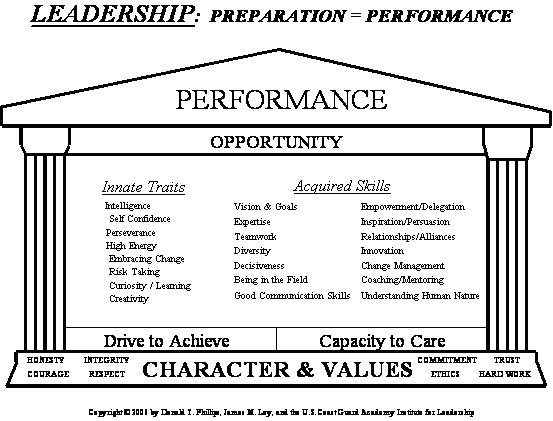One by One
From the ground up, the Coast Guard has built a culture of values-based leadership.
In any given year, the U.S. Coast Guard, the nation's smallest military service, saves an average of 5,500 lives. But in the first few weeks after Hurricane Katrina's landfall, it was credited with saving more than 33,000 lives.
And the organization didn't stop there. In the following months, it continued to deploy personnel and assets along the Gulf Coast to evacuate citizens, restore ports and waterways, respond to pollution, and provide security and law enforcement protection.
With less than 40,000 active-duty personnel (fewer than the New York City Police Department), the Coast Guard performs a dozen critical missions across 95,000 miles of U.S. coastline, 25,000 miles of inland waterways, and in many places around the world. It operates on an annual budget that amounts to less than 2 percent of the overall defense budget (less than the cost of one new aircraft carrier).
So how does the Coast Guard do so much, so efficiently, with so few people and so little money? The answer is simple and cultural.
The foundation is commitment to leadership development. All personnel, from the youngest recruit to the senior-most admiral, are immersed in the culture of leadership and expected to practice it on a daily basis.
Now, the newly created Institute for Leadership at the Coast Guard Academy offers a model that can be used as a starting point for any organization, public or private. The model starts with an unequivocal commitment to character and values. Words like honor, respect, trust and courage become the mandated norms on which the leadership culture is built.
Great leaders combine an internal drive to achieve results with an inherent capacity to care about people. In many settings, high-level executives seem unable to do both at the same time.
A recent cover story in BusinessWeek features a national retailer, whose leadership model is based on military training. The company borrowed ideas straight from field guides and military doctrine.
The company has been successful, especially in achieving annual sales goals, but the growth often has been at the expense of morale. Many employees describe a "culture of fear" that pervades the company, making it difficult for them to be creative and achieve their potential.
While the Coast Guard is a military service, it prides itself on its humanitarian purpose. The organization achieves discipline, while maintaining morale, by balancing its desire to achieve results with a capacity to care about people. They are not contradictory values, they are complementary.
The Coast Guard model also suggests that leaders are both born and made. It's important to recognize the correlation between innate traits and acquired skills. Innate traits, which are natural-born strengths, include intelligence, self-confidence, perseverance, high energy, the ability to embrace change and risk, curiosity and continual learning, and creativity. Acquired skills, on the other hand, can be learned and developed:
- Vision and goals. Fashion an inspiring vision for the organization's future, set goals and involve people in the process. Quality visions and strategic goals motivate people, focus their talents and energy, and create action, achievement and results.
- Expertise. People follow individuals from whom they can learn so they can grow and succeed.
- Teamwork. Build, develop and work with other people so the end result is greater than the sum of the individuals working separately.
- Diversity. Create a team or an organization with a balanced mixture of expertise, experience, personalities, skills, cultures and ideas.
- Decisiveness. Make high-quality tactical decisions in a timely manner with all available information at hand, creating a dynamic environment that leads to more opportunities and stronger performance.
- Connectivity. Step out of the ivory tower, interact with the workforce and establish human contact to obtain key information, keep people informed, obtain feedback, facilitate learning and understand what people think.
- Communication. Listen, engage in conversation, speak publicly, write lucidly and acquire and disseminate key information that is timely. Employees must clearly understand the organization's values, goals, vision and direction.
- Empowerment/delegation. Transfer authority to members of the organization and retain responsibility for poor results. Create an environment where employees feel comfortable and are compelled to take initiative.
- Inspiration/persuasion. Motivate people to take initiative, convince them that an undertaking is worthwhile, and encourage them to utilize their skills and talents to better themselves and the organization.
- Relationships/alliances. Form close interpersonal bonds with individuals and mutually beneficial associations with other organizations.
- Innovation. Introduce new methods, ideas and products in the organization and in the marketplace. Today's new product is often tomorrow's dinosaur, and an organization's ability to innovate equates to the ability to survive and prosper.
- Change management. Organize, coordinate and manage large-scale change. Don't let inertia cause a crisis. Stay ahead of the game by instituting ongoing consistent change. Recognize the difference between needed change and change just for the sake of change.
- Coaching/mentoring. Implement training, succession planning and development programs. Create organizations where people continually learn, adapt to change and develop career opportunities.
- Understanding human nature. Know what motivates others, how people react in different situations, how their thought processes work, and how factions and extremist points of view manifest themselves.
All this preparation eventually meets the serendipitous filter of opportunity. People must be coached to keep their eyes and ears open to new possibilities, cracks in the competition's armor and new niches in the marketplace. Ultimately, the bottom line is performance. The purpose of developing good leaders is to create successful outcomes. Meet the goals. Accomplish the mission.
This approach is affirmed by the success and efficiency of the Coast Guard. It is the values-based leadership culture that explains how the organization can be agile enough to shift its focus during a major natural disaster. It clarifies how the Coast Guard was able to save 33,000 lives while other response organizations were waiting for someone to lead.
Leadership Model

NEXT STORY: Speeding Up Acquisition Reform






